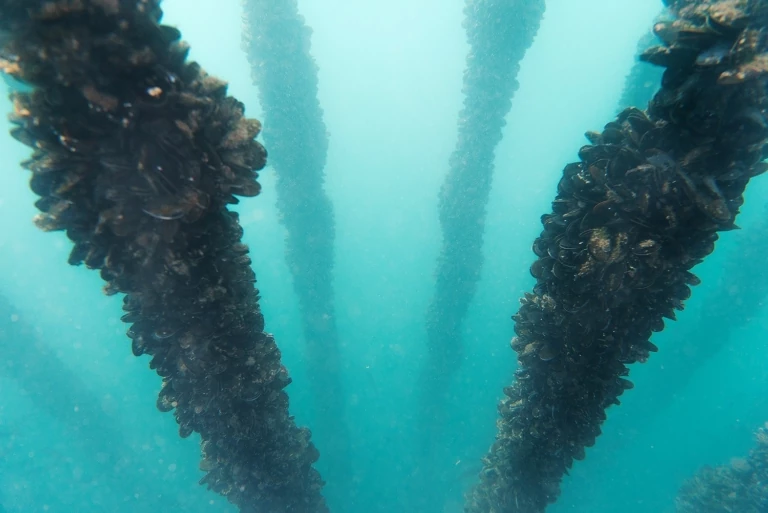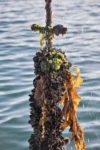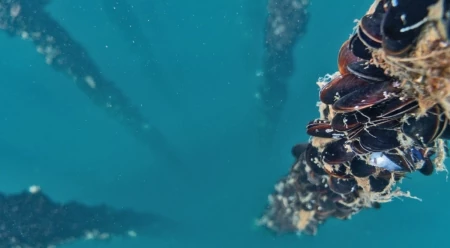The Organism that Might Just Save the Planet
When you sit down to write an eye-catching essay about seafood, your first instinct is to go with one of the sleek and sexy creatures that have historically captured the human imagination. Salmon battling 20-knot currents to reach their spawning grounds at the headwaters of the world’s mightiest rivers. Bluefin tuna charging faster than thoroughbred racehorses across the Atlantic and the Pacific and circling the bottom of the world. But when you write about sustainability and seafood, and try to consider which creatures might supply us with the most nutrition for the least amount of environmental damage, you have to revisit your definition of sexy.
Consider, then, the humble mussel
Bivalve Buddahs
Mussels, like nearly all creatures in the “bivalve” class, tend to stay put. After a brief window as free swimming adolescents, they choose a place to settle, extend a “foot” and attach themselves to a rock, a piece of wood, what have you, for pretty much the rest of their lives. Though they can in a pinch shorten their thready feet and tumble themselves to a new location, they prefer not to. They do not move to hunt their prey. They do not move to flee from predators. Rather, they grow a shell to armor their tender insides. Their only exposure to the outside world are two valves (hence “bivalve”) through which they filter their waters around them and patiently put on weight.
It is this passive, complacent act of filtration that is the quiet miracle of mussels. They are, in a sense, the Buddhas of their domain. Just as in meditation we’re told to note our inbreaths and our outbreaths and to allow ourselves to merge with the universe, mussels take in worlds of microscopic phytoplankton with every pulse of their gills. From this constant micro-buffet mussels glean energy, minerals and an array of fats (including omega-3 fatty acids.) They do this all while growing remarkably quickly. In just two years a mussel can go from the size of an infant’s pinky-nail to the width of an adult human palm. During that time that same mussel will have filtered over 10,000 gallons of water.

Photo: Darcy Turenne
What all this means is a creature that, while very modest in appearance, is in fact remarkably potent and efficient in both cleaning the ocean and providing humans with protein, fat and essential nutrients. One need only compare it to the much more frequently consumed forms of seafood for its positive qualities to shine even brighter.
Consider salmon, the most consumed finfish in America, most of which come to us in farmed form. Farmed salmon might be silvery bright on the outside and lustrous orange on the inside, but to bring all that appetizing beauty to market involves considerable environmental inputs. In the early days of salmon farming, it could take as much a six pounds of wild fish to grow a single pound of farmed salmon. To its credit, the salmon industry has greatly reduced that ratio over the last 30 years, but they have done so by putting a lot more soy and other land agricultural products into salmon feed. All this adds up to a product that costs the planet much more than a mussel. Because you don’t have to feed mussels anything at all—they feed themselves.
The Trouble with Tuna
At this point, the purists among us might throw up their hands and say, “Well forget it. From now on I’ll only eat wild seafood.” This “solution” is also remarkably shortsighted. Take for example the second most consumed seafood in America, the 23-odd species of fish grouped roughly under the market name “tuna,” most of which are wild-caught in the far corners of the world. Having overharvested our domestic tuna stocks, we now rely on tuna spirited away from the portions of the ocean that fall under no nation’s jurisdiction. Fish catches from poorly regulated “high seas” regions have increased by 800% over the course of the last decade because there is simply no more room for the tuna industry to grow any larger, and many tuna stocks are now overexploited.
And what is true of tuna is true of all wild fish. The global catch of wild seafood flat-lined at around 85 million metric tons twenty years ago and is unlikely to ever increase. Lest readers think we could farm our way out of a tuna shortage, think again. The thing that makes tuna so sexy—their speedy sleekness, their high-energy thick steaks— is the very thing that makes them poor choices for farming. Early experiments in farming tuna have shown that it can take as much as twenty pounds of wild fish to grow a single pound of farmed tuna.

Photo: Amy Kumler
Eat More to Make More?
Mussels, on the other hand, farmed well and sited correctly, can actually contribute to more fish in the sea. One of the things juvenile fish like most is something ecologists call “edge”—protected declivities that slow the speed of current and give young fish places to hide. A full-scale mussel rig increases the surface area of hiding places and thus can turn a once sterile piece of ocean into usable habitat.
So next time you sit down to contemplate your next meal, meditate a bit on the quietest, gentlest choice that lies on the interior of the mussel’s hard shell. It is our great fortune to today have easy access to this succulent deliciousness. And, unlike many passing pleasures, there is no guilt involved in consuming a mussel. Quite the contrary. Eating mussels will lead to more mussels being grown. Fields and fields of productive bivalves sitting in constructive, patient meditation, making food for the world above the surface, and shelter for the world below it.
If you ask me, that’s pretty sexy.
To learn more about the food we produce and how it’s sourced, please visit patagoniaprovisions.com.

